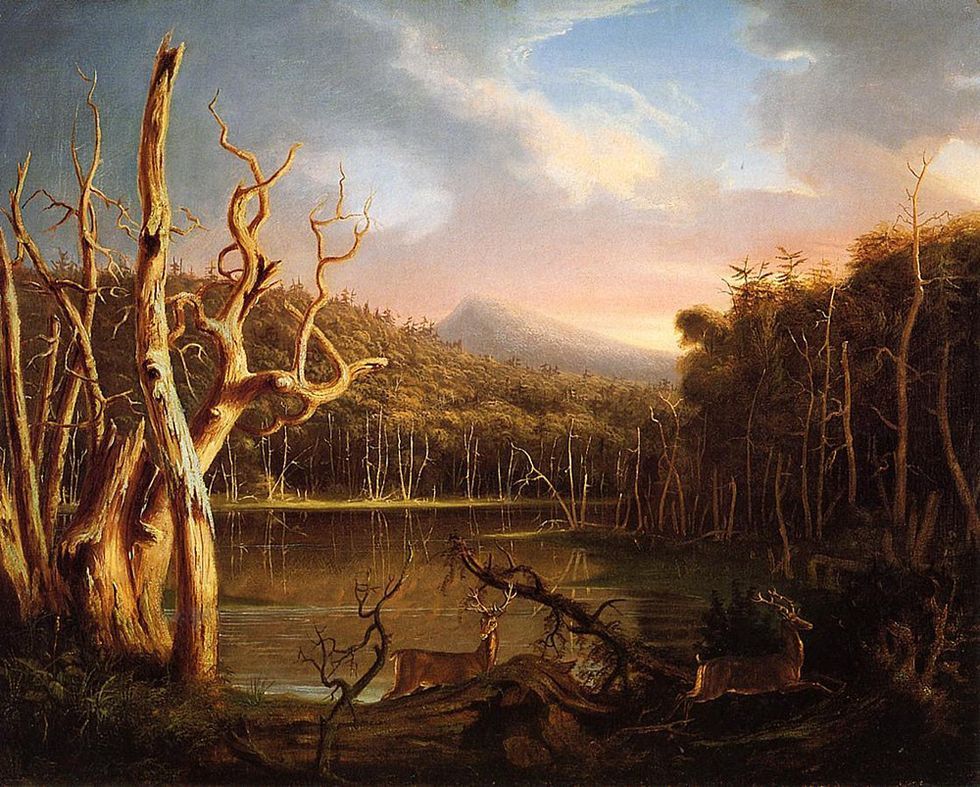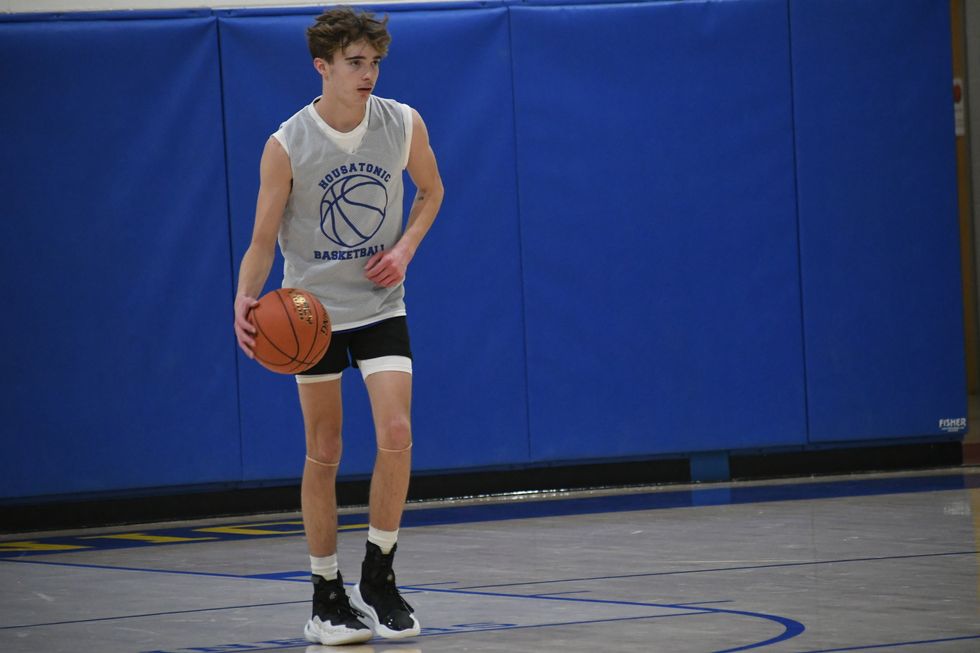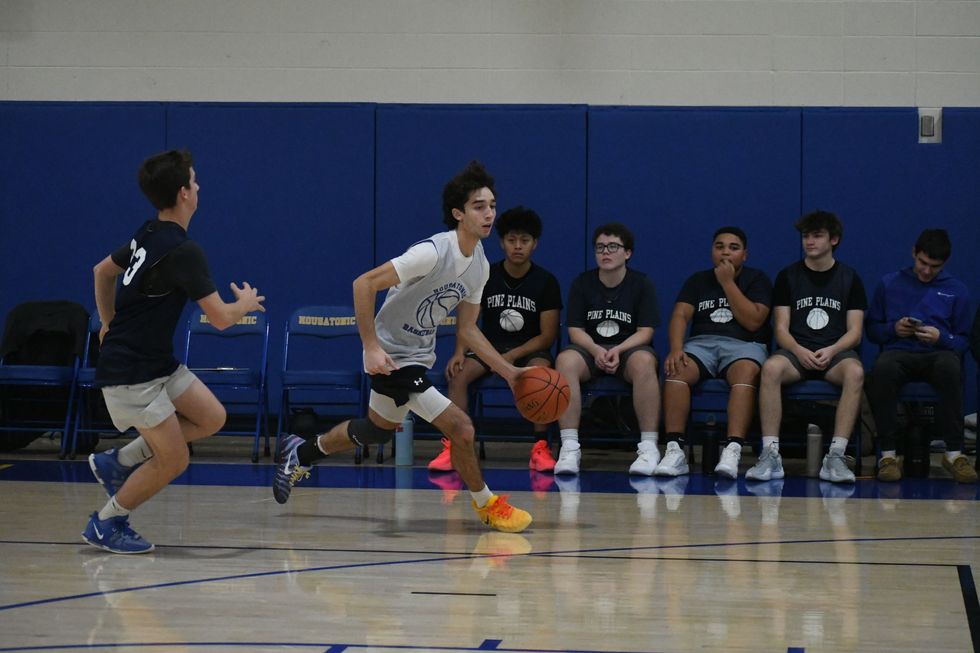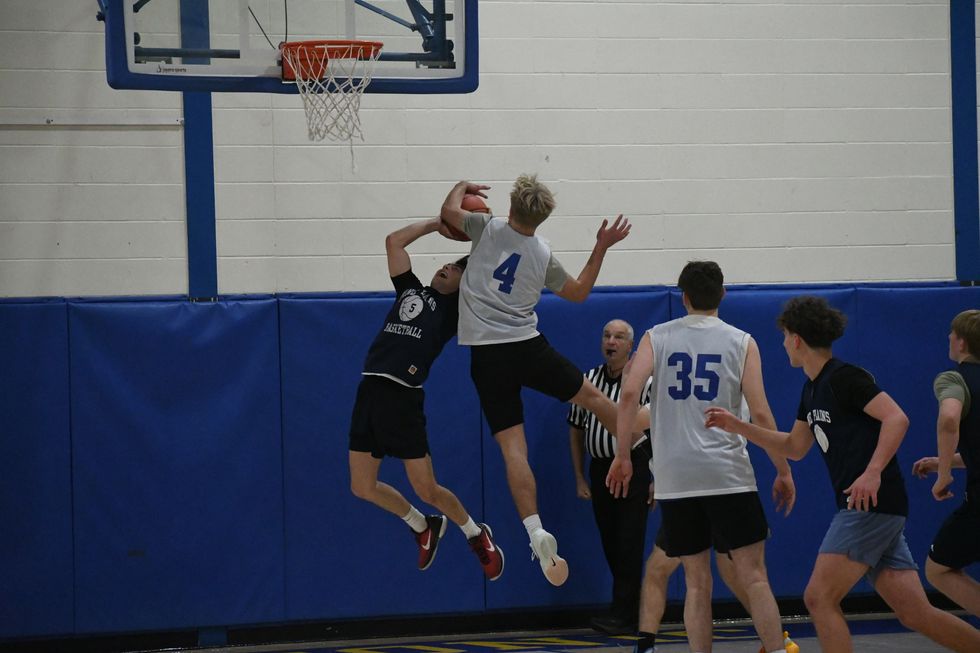Cary Lecture Highlights Prehistoric Formation of Artistic Landscape

Dover Plains, Dutchess County, New York, 1848 by Asher B. Durand Courtesy of the Smithsonian American Art Museum

‘Our part of the world is a gift of the Ice Age,” stated Johanna Titus during a virtual lecture on Wednesday, Jan. 18, presented by the Cary Institute for Ecosystem Studies. She and her husband, Robert — both of them scientists, authors, and journalists as well as longtime residents of the Hudson Valley and Catskills — discussed the landscapes expressed by artists of the Hudson River School and their geological foundations in a lecture titled “The Hudson River School of Art and Its Ice Age Origins.”
“The geologic processes of the Wisconsin glaciation, more commonly known as the last ice age, shaped the landscapes and defined the first art movement in America: the Hudson River School of Art,” said Johanna.
Blogging at www.thecatskillgeologist.com, the Tituses have spent countless hours researching and exploring the Catskills, especially the area known to Hudson River School artist and founder Thomas Cole, who Johanna called “the movement’s heart.” Cole’s first trip to the Catskills resulted in his 1825 painting “Lake With Dead Trees,” which was created in what is now North-South Lake Campground in Hunter, one of the most popular state parks in New York.
After a bit more background and identification of other Hudson River School artists including Asher Brown Durand, Robert began his explanation of the geology of the region with how the aforementioned North Lake and was created by a glacier.
“North Lake and South Lake weren’t always there,” said Robert. “Fifteen thousand years ago, they did not exist. But then 14,000 years ago, the glaciers came along and scoured out these basins.”
The Tituses continued in much the same vein throughout the talk, with Johanna identifying key landscape features in various Hudson River School artworks and Robert examining how said features were formed.
“The climate eventually changed . . . all that ice began melting and all that meltwater glutted the local streams, and they eroded into even more scenic landscapes,” Johanna explained, discussing the formation of glacial Lake Albany and how the valley captured in Durand’s 1848 painting “Dover Plains, Dutchess County, New York” is the lake bottom.
“The Hudson River School painters were painting at a place in time when a lot of science was changing,” said Johanna.
For those who were interested in seeing the physical locations depicted in the Hudson River School artworks, the Tituses pointed to the existence of the Hudson River Art Trail, a project of the Thomas Cole National Historic Site in Catskill, as well as the Tituses’ own forthcoming book that will include “probably 100 locations and directions on how to get to them and what you’re going to see when you get there,” according to Robert.
“We write mostly about the geology of the region and how the geology influenced the culture of the Catskills and, of course, the greater Hudson Valley,” Johanna said. “We often talk about the paintings where the Hudson River is seen and the fact that there is no industry in those paintings. . . . [They] decided to paint that stuff out, and I think it was just to encourage people to come and see the beauty of the place.”
A video of the program is available to watch at the Cary Institute’s website at www.caryinstitute.org and its YouTube channel.

Lake with Dead Trees, 1825 by Thomas Cole Courtesy of the Allen Memorial Art Museum
Ryan Segalla takes a fadeaway shot over a defender.
FALLS VILLAGE — Housatonic Valley Regional High School’s boys basketball team defeated Pine Plains High School 60-22 in a scrimmage Tuesday, Dec. 9. The non-league preseason game gave both sides an opportunity to run the court ahead of the 2025-26 varsity season.
HVRHS’s senior-heavy roster played with power and poise. The boys pulled ahead early and kept their foot on the gas through to the end.
By halftime the score was 33-8. Junior varsity players subbed in for the second half, but not before the starters got some in-game dunk practice. By the end Housatonic totaled 60 points to Pine Plains’ 22.

Nick Crodelle led the Mountaineers offensively with 13 points. Anthony Labbadia and Wyatt Bayer scored nine points each. Anthony Foley scored eight points. Owen Riemer and Ryan Segalla each scored seven points. Peyton Bushnell hit a three-pointer. Jaxon Visockis and Henry Berry each scored two points.
HVRHS begins Berkshire League competition on the road at Nonnewaug High School Tuesday, Dec. 16, with a 6 p.m. tip off.


Katie Moore delivers toys to the Stuff a Truck campaign held by the Kent Volunteer Fire Department last weekend. Donated toys are collected so that parents, who need some assistance, may provide their children with gifts this Christmas. Accepting the donation are elves Fran Goodsell and Karen Iannucci
KENT — Santa’s elves were toasty warm as they collected toys for the children of Kent.
Keeping with annual tradition, Fran Goodsell and Karen Iannucci manned the Stuff a Truck campaign sponsored by the Kent Volunteer Fire Department on Saturday, Dec. 6, and Sunday, Dec. 7. Sitting in front of a fire pit in the firehouse parking lot between donations from residents, they spoke of the incredible generosity displayed every season. That spirit of giving was clear from the piles of toys heaped on a table.
“This is always so gratifying,” said Goodsell, noting that certain businesses, including High Watch Recovery Center, Wilson’s, and Kent and South Kent schools needed a “shout out” for all they’ve done. She said South Kent School focuses on gifts for older children, which is a group that often is overlooked.
Unwrapped contributions are sought for children 1 to 15 years old who might otherwise find little or nothing from Santa, they said. The bounty will be set up at the Community House on Thursday, allowing parents to come and take what they want. If there are still items left, grandparents are invited to “shop.”
The atmosphere was festive Saturday, as a stuffed dog began barking a Christmas tune whenever someone walked in front of it. A large decked-out bear posted at the parking lot entrance reminded passersby of the event. Visiting children were able to get a close-up look at the fire truck and walk through the firehouse if they wished.
Goodsell and Iannucci were very grateful to those who donated wood for the fire pit. “And so many asked if they could bring us coffee or hot chocolate,” said Iannucci.
Goodsell said many who came talked about having grown children who were recipients of the gifts when their families were struggling. “They are so glad to be able to give back,” she said.
Housatonic Valley Regional High School
FALLS VILLAGE — Principal Ian Strever announces the first quarter marking period Honor Roll at Housatonic Valley Regional High School for the 2025-26 school year.
Highest Honor Roll
Grade 9
Katelyn Holst-Grubbe (North Canaan), Meriel Hughes (Salisbury), Noell Laurry (Kent), Keely Malone (Sharon), April Puerto (Salisbury), Solomon Schmidt (Salisbury), Alastair Schnepf (Wassaic), Olivia Simonds (North Canaan), Marisol Vaughn (Kent), Emery Wisell (Kent).
Grade 10
Mia Belter (Salisbury), Louise Faveau (Salisbury), Addison Green (Kent), Aryanna Horton (Salisbury), Eliana Lang (Salisbury), Lily McCabe (Salisbury), Alison McCarron (Kent), Katherine Money (Kent), Mira Norbet (Sharon), Abigail Perotti (North Canaan), Owen Schnepf (Wassaic), Schuyler Thompson (Falls Village), Federico Vargas Tobon (Salisbury).
Grade 11
John DeDonato (Salisbury), Natasha Dennis (North Canaan), Adelyn Diorio (North Canaan), Sydney Howe (North Canaan), Daniel Lesch (Cornwall), Finian Malone (Sharon), Meadow Moerschell (Kent), Ishaan Tantri (Salisbury).
Grade 12
Lily Beurket (Cornwall), Ryder Conte (Falls Village), Shanaya Duprey (North Canaan), Evelyn Flores-Hernandez (North Canaan), Madelyn Johnson (North Canaan), Alexa Meach (North Canaan), Ibby Sadeh (Falls Village), Alex Woodworth (Salisbury).
High Honor Roll
Grade 9
Anna Ayer (Salisbury), Cody Bodwell (Cornwall), Lainey Diorio (North Canaan), Emma Duffy (Sharon), Carter Finney (North Canaan), Elden Grace (Salisbury), Joanna Haratyk (Torrington), Ava Humes (North Canaan), Tyler LaPlante (North Canaan), Sawyer Margerelli (Salisbury), Lola Miller (Falls Village), Grace O’Brocki (Salisbury), August Olson (Falls Village), Elexis Petkovich (North Canaan), Donald Polk (Cornwall), Justin Sorell (North Canaan), Gia Torzilli (Gaylordsville), Scarlett Visconti (North Canaan), Jaxon Visockis (Salisbury).
Grade 10
Krystin Ackerman (North Canaan), Paige Beeman (North Canaan), Max Bochnovich (Salisbury), Nico Bochnovich (Salisbury), Logan Bronson (Cornwall), Lucius Bryant (Cornwall), Zaira Celso-Cristobal (Sharon), Winter Cheney (Cornwall), Tess Churchill (Salisbury), Niki Clark (Salisbury), Caitlin Devino (North Canaan), Luca Floridis (Salisbury), Samuel Garcia Pulido (North Canaan), Beatrice Gifford (Kent), Angel Gonzalez (Salisbury), Kartel Henry (North Canaan), Paul Losh (Falls Village), Wyatt Merwin (Salisbury), Logan Miller (Falls Village), Sadie Morales Chapell (Salisbury), Nova Pratt (North Canaan), Karmela Quinion (North Canaan), Vilija Salazar (Kent), Juliette Trabucco (Kent), Payton Wagner (North Canaan), Olivia Whitney (North Canaan).
Grade 11
Adelaide Almeida (Salisbury), Hayden Bachman (Falls Village), Byron Bell (Cornwall), Sophia Camphouse (Sharon), Olivia Claydon (North Canaan), Georgie Clayton (Salisbury), Sophia DeDominicis Fitzpatrick (Sharon), Christian DeDonato (Salisbury), Layla DiDomenico (Kent), Carmela Egan (Salisbury), Kellie Eisermann (Salisbury), Levi Elliott (Millerton), Lydia Fleming (North Canaan), Guadalupe Flores-Hernandez (North Canaan), Grace Graney (Falls Village), Alexa Hoadley (Kent), Jonas Johnson (North Canaan), Aiden Krupa (Torrington), Makenzie Lidstone (Salisbury), Francisco Mendoza Ratzan (North Canaan), Daniel Moran (Norfolk), Jackson Olson (Falls Village), Logan Padelli (North Canaan), Gustavo Portillo (North Canaan), Darwin Wolfe (Falls Village), Nathan Zani (Ashley Falls), Ivy Zheng (North Canaan).
Grade 12
Hayden Bell (Cornwall), Genesis Bravo Guilcashina (North Canaan), Olivia Brooks (Salisbury), Victoria Brooks (Salisbury), Mia DiRocco (Cornwall), Anthony Foley (North Canaan), Anna Gillette (Salisbury), Julissa Gonzalez (Cornwall), Kierra Greene (North Canaan), Adam Hock (Kent), Sara Ireland (Salisbury), Hannah Johnson (North Canaan), Riley Mahaffey (Amenia), Simon Markow (Cornwall), Madeline Mechare (Falls Village), Madison Melino (Austerlitz), Daphne Paine (North Canaan), Celeste Trabucco (Kent), Silas Tripp (Falls Village), Ayden Wheeler (Amenia).
Honor Roll
Grade 9
Jonathan Bindley (Cornwall), Cullen Bonis (Kent), Phoebe Conklin (Salisbury), Connor Crane (North Canaan), Isabella Curtis (Norfolk), Jessica Davis (North Canaan), Ciri Dean (North Canaan), Lyla Diorio (North Canaan), Patrick Hafner (Falls Village), Ryan Hinman (North Canaan), Harrison Morey (North Canaan), Jenaveeve Wagner (North Canaan).
Grade 10
Lyla Banffy (Kent), Jackson Brammer (Sharon), Peyton Bushnell (Falls Village), Alisa Christiansen Madsen (North Canaan), Lilliana Hurley (North Canaan), Chase Kading (Millerton), Ayden Lemmy (Falls Village), McKenzie Lotz (Ashley Falls), Christopher Piscitello (North Canaan), Camila Sanchez Guerrero (Cornwall), Henry Skuza (Millbrook), Giovani Solorzano-Lemus (North Canaan), Nathan Young (Cornwall).
Grade 11
Bennett Wyatt Bayer (Salisbury), Sofia Bindley (Cornwall), Selena Black (Cornwall), Karen Chavez-Sanchez (Salisbury), Riley Heady (Sharon), Carson Riva (North Canaan), Ryan Segalla (Salisbury), Alanna Tatro (North Canaan), Juan Xeche Coche (North Canaan).
Grade 12
Peter Austin (Kent), Katherine Crane (North Canaan), Richard Crane (North Canaan), Nicholas Crodelle (Sharon), Mollie Ford (Falls Village), Nicolas Gonzalez (Salisbury), Maureen Graney (Falls Village), Taylor Green (Kent), Marc Hafner (Falls Village), Chloe Hill (Salisbury), Abram Kirshner (Kent), Logan Labshere (North Canaan), Eric Lopez Espinosa (Salisbury), Owen Riemer (North Canaan), Ava Segalla (Salisbury), Cole Simonds (North Canaan).
NORTH CANAAN — The Board of Finance elected its officers at the first meeting of the new term on Wednesday, Dec. 10.
Doug Humes was re-elected as chair, and Brian Johnson was elected vice chair.
The board also filled a two-year vacancy by unanimously appointing Christian Allyn, who was sworn in immediately by Town Clerk Jean Jacquier.
Members then reviewed several budget line items that have exceeded their appropriations and will require the approval at a town meeting.
First Selectman Jesse Bunce, who attended the meeting, said the Board of Selectmen will likely call for that town meeting when it convenes on Monday, Dec. 15.